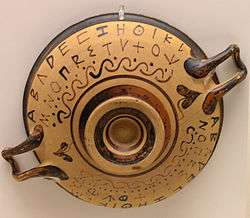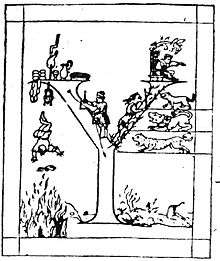Upsilon
 | ||||||||||||||||||||||||||||||||||||||||||||||||
| Greek alphabet | ||||||||||||||||||||||||||||||||||||||||||||||||
|---|---|---|---|---|---|---|---|---|---|---|---|---|---|---|---|---|---|---|---|---|---|---|---|---|---|---|---|---|---|---|---|---|---|---|---|---|---|---|---|---|---|---|---|---|---|---|---|---|
|
||||||||||||||||||||||||||||||||||||||||||||||||
| History | ||||||||||||||||||||||||||||||||||||||||||||||||
| Use in other languages | ||||||||||||||||||||||||||||||||||||||||||||||||
| Related topics | ||||||||||||||||||||||||||||||||||||||||||||||||
| ||||||||||||||||||||||||||||||||||||||||||||||||
Upsilon (uppercase Υ, lowercase υ; Greek: ύψιλον, ýpsilon, [ˈipsilon]; /ˈʌpsᵻlɒn, ˈjuːp-, ˈuːp-, ˈʊp-, -lən/; or UK /ʌpˈsaɪlən, juːp-/[1][2][3][4]) is the 20th letter of the Greek alphabet. In the system of Greek numerals, Υʹ has a value of 400. It is derived from the Phoenician waw ![]() .
.

Etymology
The name of the letter was originally just “υ” (y; also called hy, hence "hyoid", meaning "shaped like the letter υ"), but the name changed to “υ ψιλόν”, (u psilon, meaning 'simple u') to distinguish it from οι, which had come to have the same [y] pronunciation.[5]
Pronunciation
In early Greek it was pronounced like English oo [u]. In Classical Greek, it was pronounced like French u or German ü, i.e., [y] (a sound that is not found in most dialects of English). This was the case at least until the year 1030AD.[6] In Modern Greek it is pronounced like continental i or English ee, [i], and in diphthongs, [f] or [v]. In ancient Greek, it occurred in both long and short versions, but this distinction has been lost in Modern Greek.
As an initial letter in Classical Greek it always carried the rough breathing (equivalent to h) as reflected in the many Greek-derived English words, such as those that begin with hyper- and hypo-. This rough breathing was derived from an older pronunciation that used a sibilant instead; this sibilant was not lost in Latin, giving rise to such cognates as super- (for hyper-) and sub- (for hypo-).
Upsilon participated as the second element in falling diphthongs, which have subsequently developed in various ways: For instance, after alpha or epsilon it is pronounced [f] or [v] in Modern Greek.
Correspondence with Latin Y

The usage of Y in Latin dates back to the first century BC. It was used to transcribe loanwords from Greek, so it was not a native sound of Latin and was usually pronounced /u/ or /i/. The latter pronunciation was the most common in the Classical period and was used mostly by uneducated people. The Roman Emperor Claudius proposed introducing a new letter into the Latin alphabet to transcribe the so-called sonus medius (a short vowel before labial consonants), but in inscriptions, the new letter was sometimes used for Greek upsilon instead.
Four letters of the Latin alphabet arose from it: V and Y and, much later, U and W. In the Cyrillic script, the letters U (У, у) and izhitsa (Ѵ, ѵ) arose from it.
In some languages (most notably German), the name upsilon (Ypsilon in German, ípsilon in Portuguese) is used to refer to the Latin letter Y as well as the Greek letter.
Usage
- In particle physics the capital Greek letter Υ denotes an Upsilon particle. Note that the symbol should always look like in order to avoid confusion with a Latin Y denoting the hypercharge.
- Automobile manufacturer Lancia has a model called the Ypsilon. See Lancia Ypsilon.
- In linguistics, the symbol is used to represent a labiodental approximant.
- In astrophysics and physical cosmology, refers to the mass-to-light ratio.[7]
Symbolism

Upsilon is known as Pythagoras' letter, or the Samian letter, because Pythagoras used it as an emblem of the path of virtue or vice.[8] As the Roman writer Persius wrote in Satire III:
and the letter which spreads out into Pythagorean branches has pointed out to you the steep path which rises on the right.[9]
Lactantius, an early Christian author (ca. 240 – ca. 320), refers to this:
For they say that the course of human life resembles the letter Y, because every one of men, when he has reached the threshold of early youth, and has arrived at the place "where the way divides itself into two parts," is in doubt, and hesitates, and does not know to which side he should rather turn himself.[10]
Character encodings
- Greek Upsilon
| Character | Υ | υ | ϒ | |||
|---|---|---|---|---|---|---|
| Unicode name | GREEK CAPITAL LETTER UPSILON | GREEK SMALL LETTER UPSILON | GREEK UPSILON WITH HOOK SYMBOL | |||
| Encodings | decimal | hex | decimal | hex | decimal | hex |
| Unicode | 933 | U+03A5 | 965 | U+03C5 | 978 | U+03D2 |
| UTF-8 | 206 165 | CE A5 | 207 133 | CF 85 | 207 146 | CF 92 |
| Numeric character reference | Υ | Υ | υ | υ | ϒ | ϒ |
| Named character reference | Υ | υ | ϒ | |||
| DOS Greek | 148 | 94 | 172 | AC | ||
| DOS Greek-2 | 209 | D1 | 239 | EF | ||
| Windows 1253 | 213 | D5 | 245 | F5 | ||
| TeX | \Upsilon | \upsilon | ||||
- Coptic Ua
| Character | Ⲩ | ⲩ | ||
|---|---|---|---|---|
| Unicode name | COPTIC CAPITAL LETTER UA | COPTIC SMALL LETTER UA | ||
| Encodings | decimal | hex | decimal | hex |
| Unicode | 11432 | U+2CA8 | 11433 | U+2CA9 |
| UTF-8 | 226 178 168 | E2 B2 A8 | 226 178 169 | E2 B2 A9 |
| Numeric character reference | Ⲩ | Ⲩ | ⲩ | ⲩ |
- Latin Upsilon
| Character | Ʊ | ʊ | ᶷ | ᵿ | ||||
|---|---|---|---|---|---|---|---|---|
| Unicode name | LATIN CAPITAL LETTER UPSILON | LATIN SMALL LETTER UPSILON | MODIFIER LETTER SMALL UPSILON | LATIN SMALL LETTER UPSILON WITH STROKE | ||||
| Encodings | decimal | hex | decimal | hex | decimal | hex | decimal | hex |
| Unicode | 433 | U+01B1 | 650 | U+028A | 7607 | U+1DB7 | 7551 | U+1D7F |
| UTF-8 | 198 177 | C6 B1 | 202 138 | CA 8A | 225 182 183 | E1 B6 B7 | 225 181 191 | E1 B5 BF |
| Numeric character reference | Ʊ | Ʊ | ʊ | ʊ | ᶷ | ᶷ | ᵿ | ᵿ |
- Mathematical Upsilon
| Character | 𝚼 | 𝛖 | 𝛶 | 𝜐 | 𝜰 | 𝝊 | ||||||
|---|---|---|---|---|---|---|---|---|---|---|---|---|
| Unicode name | MATHEMATICAL BOLD CAPITAL UPSILON | MATHEMATICAL BOLD SMALL UPSILON | MATHEMATICAL ITALIC CAPITAL UPSILON | MATHEMATICAL ITALIC SMALL UPSILON | MATHEMATICAL BOLD ITALIC CAPITAL UPSILON | MATHEMATICAL BOLD ITALIC SMALL UPSILON | ||||||
| Encodings | decimal | hex | decimal | hex | decimal | hex | decimal | hex | decimal | hex | decimal | hex |
| Unicode | 120508 | U+1D6BC | 120534 | U+1D6D6 | 120566 | U+1D6F6 | 120592 | U+1D710 | 120624 | U+1D730 | 120650 | U+1D74A |
| UTF-8 | 240 157 154 188 | F0 9D 9A BC | 240 157 155 150 | F0 9D 9B 96 | 240 157 155 182 | F0 9D 9B B6 | 240 157 156 144 | F0 9D 9C 90 | 240 157 156 176 | F0 9D 9C B0 | 240 157 157 138 | F0 9D 9D 8A |
| UTF-16 | 55349 57020 | D835 DEBC | 55349 57046 | D835 DED6 | 55349 57078 | D835 DEF6 | 55349 57104 | D835 DF10 | 55349 57136 | D835 DF30 | 55349 57162 | D835 DF4A |
| Numeric character reference | 𝚼 | 𝚼 | 𝛖 | 𝛖 | 𝛶 | 𝛶 | 𝜐 | 𝜐 | 𝜰 | 𝜰 | 𝝊 | 𝝊 |
| Character | 𝝪 | 𝞄 | 𝞤 | 𝞾 | ||||
|---|---|---|---|---|---|---|---|---|
| Unicode name | MATHEMATICAL SANS-SERIF BOLD CAPITAL UPSILON | MATHEMATICAL SANS-SERIF BOLD SMALL UPSILON | MATHEMATICAL SANS-SERIF BOLD ITALIC CAPITAL UPSILON | MATHEMATICAL SANS-SERIF BOLD ITALIC SMALL UPSILON | ||||
| Encodings | decimal | hex | decimal | hex | decimal | hex | decimal | hex |
| Unicode | 120682 | U+1D76A | 120708 | U+1D784 | 120740 | U+1D7A4 | 120766 | U+1D7BE |
| UTF-8 | 240 157 157 170 | F0 9D 9D AA | 240 157 158 132 | F0 9D 9E 84 | 240 157 158 164 | F0 9D 9E A4 | 240 157 158 190 | F0 9D 9E BE |
| UTF-16 | 55349 57194 | D835 DF6A | 55349 57220 | D835 DF84 | 55349 57252 | D835 DFA4 | 55349 57278 | D835 DFBE |
| Numeric character reference | 𝝪 | 𝝪 | 𝞄 | 𝞄 | 𝞤 | 𝞤 | 𝞾 | 𝞾 |
These characters are used only as mathematical symbols. Stylized Greek text should be encoded using the normal Greek letters, with markup and formatting to indicate text style.
Notes
- ↑ "Upsilon". Merriam-Webster Dictionary. Retrieved 2016-01-22.
- ↑ "Upsilon". Oxford Dictionaries. Oxford University Press. Retrieved 2016-01-22.
- ↑ "Upsilon". Dictionary.com Unabridged. Random House. Retrieved 2016-01-22.
- ↑ Oxford English Dictionary, 3rd ed. "upsilon, n." Oxford University Press (Oxford), 2013.
- ↑ See W. Sidney Allen, Vox Graeca, 3rd ed., Cambridge 1987, p. 69.
- ↑ F. Lauritzen, Michael the Grammarian's irony about Hypsilon. A step towards reconstructing Byzantine pronunciation. Byzantinoslavica, 67 (2009)
- ↑ Mihalas and McRae (1968), Galactic Astronomy (W. H. Freeman)
- ↑ Brewer, Ebenezer Cobham. The reader's handbook of famous names in fiction, allusions, references, proverbs, plots, stories, and poems, Vol. 2, p. 956. Lippincott, 1899.
- ↑ Satires.
|first1=missing|last1=in Authors list (help) - ↑ The Divine Institutes. pp. Book VI Chapter III.
|first1=missing|last1=in Authors list (help) - ↑ Unicode Code Charts: Greek and Coptic (Range: 0370-03FF)
External links
| Look up Υ or υ in Wiktionary, the free dictionary. |
- Merrifield, Michael (2009). "γ – Mass to Light Ratio". Sixty Symbols. Brady Haran for the University of Nottingham.